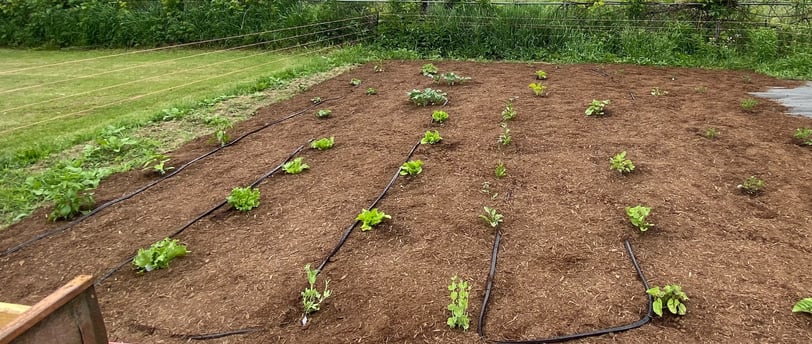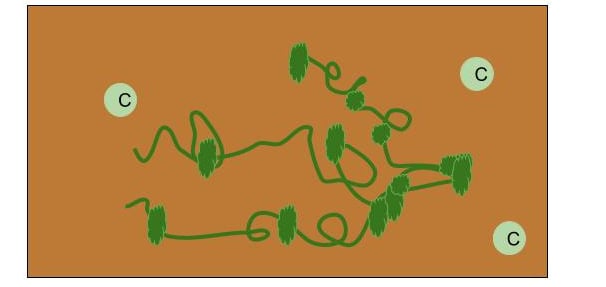Plan A Spring Garden With Companion Planting
Plan a spring garden with companion planting and set yourself up for low-maintenance gardening season. Companion planting to bring many benefits to the garden such a pest prevention, attracting pollinators, supporting vining plants and more that will save your hours of time and money.
BLOG
2/22/202511 min read


3. Watermelon + Cilantro
After several seasons of experimenting with watermelon cultivation, we finally celebrated our first successful harvest last year. This accomplishment has inspired us to enhance our gardening practices further. To promote healthier growth and potentially increase our yield, we've decided to introduce cilantro as a companion plant. With careful attention and nurturing, we are optimistic about achieving even greater results this year.
Benefits: Pest deterrent, Pollinator Attractor
Cilantro serves a dual purpose in the garden ecosystem, acting as both a magnet for beneficial insects and a natural pest deterrent. Its fragrant leaves attract a variety of pollinators, including bees, which are essential for the reproduction of many plants. Additionally, cilantro lures predator insects like parasitoid wasps, hoverflies, lacewings, and ladybugs, all of which play a crucial role in managing pest populations. The unique aroma released by cilantro's foliage is not just appealing to friendly insects; it also assists in repelling common garden pests such as aphids, flies, spider mites, moths, and potato beetles. By incorporating cilantro into your garden, you can create a healthier environment that promotes pollination while simultaneously keeping harmful insects at bay.
Planting Method: When planting cilantro alongside watermelon, we can rest easy knowing that cilantro won't obstruct sunlight needed for the melons' growth. However, it's essential to pay careful attention to the watering needs of both plants. By positioning the cilantro at a reasonable distance from the watermelon, we ensure that each can thrive with the appropriate amount of water. Regularly monitoring their moisture levels will help prevent overwatering or underwatering, allowing both plants to flourish in their respective zones. With proper care, we can enjoy a successful harvest of fresh cilantro and juicy watermelon.








What plant companion would you try in your own garden?
As we reflect on the success or challenges of our selected companions, we hope to gain valuable insights into the benefits of companion planting. There are many combinations that exist that we haven't listed here or tried yet. If you're looking to enhance your own garden, consider experimenting with suitable plant companions tailored to your specific gardening conditions. By researching and selecting the optimal pairings, you can create a thriving environment for your plants, unlocking their full potential while cultivating a vibrant garden ecosystem.
Gardening is an accessible and rewarding endeavor that anyone can embrace. It thrives on the principles of learning, experimentation, and personal adaptation. By starting with just one plant companion, you can discover what works best for you and your gardening style.
Reflect on the benefits that this pairing brings to your garden—is there an increase in growth, or do the plants seem healthier together? Many gardeners have found success using similar methods, so sharing your experiences can inspire others.
Join the conversation and let us know how companion planting has worked for you! Here in zone 6A, warm weather looks like its right around the corner! Stay tuned next week for more tips and guidance to prepare your garden for a successful growing season. Your journey in gardening begins with exploration and observation, and the possibilities are endless! Have a question or a suggestion for a gardening topic? Let us know, fill out the form below!
Companion planting offers a multitude of benefits for gardeners by leveraging the natural relationships between plants, animals, and insects. This approach allows gardeners to harness the power of nature, rather than fighting against it, creating a harmonious ecosystem that thrives with minimal intervention. By strategically pairing certain plants, beneficial insects can be attracted, pests can be deterred, and soil health can be improved, leading to a flourishing garden with less effort. A low-maintenance food forest can be easily established in any backyard, providing not only a sustainable source of food but also enhancing biodiversity and resilience in the landscape. Embracing these natural connections can transform a simple garden into a thriving, productive environment.
5. Tomato + Basil + Okra
In our garden, we take immense joy in cultivating tomatoes and basil, two staples that thrive beautifully together. This year, we plan to expand our basil production. Additionally, we're excited to use this opportunity to give okra another shot. Each year we try our hand at growing okra, we gain invaluable insights and experience, learning more about its needs and how to care for it.
Benefits: Pest deterrent, Pollinator Attractor
Basil is not just a flavorful herb; it also serves as a natural repellent for harmful insects such as thrips and moths, which are known to lay eggs on tomato plants, resulting in the notorious tomato hornworm. When tomato plants are strategically planted alongside okra, they can function as a trap crop, drawing pests away from the okra and toward themselves. Additionally, the strong aroma of basil provides an extra layer of protection, effectively masking both the tomato and okra from the attention of potential pests. If you let the basil go to flower later in the season it also attracts beneficial pollinators. This combination creates a more balanced and pest-resistant garden, allowing both crops to thrive without the threat of significant insect damage.
Planting Method: In our garden, we have devised a strategic plan for planting, arranging our crops in neat rows to allow ample space for their growth. By alternating our plants, we ensure each one has enough room to thrive as it matures. To enhance the advantages of companion planting, we will intersperse basil among the tomato and okra plants. This arrangement not only maximizes space but also provides vital bug-repelling benefits from the basil to both the tomato and okra, helping to safeguard them from pests. Such a deliberate layout fosters a harmonious ecosystem, promoting healthy growth and greater productivity in our garden. With careful planning and consideration, we are excited to cultivate a thriving garden that supports the well-being of all its plants.
4. Radish + Flowers + Squash
(Zucchini, Summer Squash, Butternut squash, Spaghetti squash, Acorn squash, Pumpkin)
In our garden, we take great pleasure in cultivating squash, often reaping a bountiful harvest. Additionally, we scatter vibrant marigolds throughout the garden, enhancing its beauty and attracting beneficial insects. This year, we're excited to broaden our gardening knowledge by learning how to grow radishes. Alongside radishes, we aim to explore various flowers that can complement our existing floral arrangements. By carefully selecting these new additions, we hope to create a thriving ecosystem in our garden, where every plant contributes to the overall health and resilience of our beloved gardening space.
Benefits: Pest deterrent, Pollinator Attractor
Flowers play a vital role in supporting the ecosystem by attracting beneficial pollinators while also deterring harmful insects. Zinnias, with their abundant nectar, are particularly effective at drawing in bees and butterflies, making them a favorite among garden enthusiasts. In contrast, marigolds not only invite pollinators but also serve as a natural repellant for pesky pests like squash vine borers. Additionally, radishes contribute to garden health by keeping undesirable squash bugs at bay. By incorporating these plants into gardens, homeowners can create a vibrant and balanced environment that nurtures pollination while minimizing pest problems.
Planting Method: In our garden design, we will strategically plant zucchini and summer squash in mounds due to their compact vine growth. This method allows us to maximize space and simplify management as the plants develop throughout the growing season. Complementing the squash, we will also bunch flowers like zinnias and marigolds in various areas both within and outside the garden, enhancing the aesthetic appeal and ecological balance. As the season unfolds, the vining squash will intertwine with the colorful flower clusters, creating a vibrant tapestry of plants. Additionally, we plan to sow radishes in close proximity to the squash in small groups, facilitating easier care as the season progresses. This cohesive planting strategy not only promotes healthy growth but also fosters a flourishing garden ecosystem.
Welcome Back Gardeners!
Winter serves as the perfect opportunity for gardeners to strategize for the upcoming growing season. After determining what crops to cultivate, it's essential to research effective growing methods tailored to those plants. Understanding plant companionships can immensely enhance a gardener's efficiency and yield, allowing one to work smarter rather than harder.
After successfully setting up our garden last year (shown in the photo above), we reflected on our experience and took notes on how to improve our harvest for this season. Additionally, we realized that there was still a significant amount of planting space that remained underutilized last year. This season, we are determined to make the most of that space by filling it out with more diverse plants. One of the key strategies we decided to implement is companion planting. By pairing certain plants together, we hope to enhance their growth and yields. We are excited to see how these changes will positively impact our garden, leading to a more bountiful harvest and a thriving ecosystem in our backyard. With careful planning and an open mind, we look forward to experimenting and learning along the way.
This season, we’re excited to grow various plants that we've carefully selected during the winter months. By sharing the 5 planting companions we’ve chosen, we aim to illustrate how these relationships will not only boost our yields but also save us money. Embracing the art of companion planting will ultimately create a more thriving and cost-effective garden, ensuring a fruitful season ahead.
What is companion planting?
Companion planting is a beneficial strategy for gardeners looking to enhance their gardening practices while minimizing effort. By understanding and utilizing the relationships between different plants, gardeners can create a harmonious environment where plants support each other. This thoughtful approach not only fosters a thriving garden but also promotes biodiversity and sustainability.
Companion planting offers a range of benefits that can enhance the overall health and productivity of a garden. There are seven key advantages to consider, with many plants providing multiple benefits. Certain companion plants can deter pests, keeping harmful insects away from more vulnerable crops. Others attract beneficial insects that aid in pollination and pest control. Additionally, some plants offer shade for smaller varieties, while others provide support for vining species to thrive. Companion plants can also improve soil health by removing harmful substances and increasing nitrogen availability, promoting robust growth. Furthermore, plants can play a role in suppressing weed growth, allowing crops to flourish without competition.
Companion planting offers a remarkable way to enhance the productivity and resilience of fruits, vegetables, and herbs in the garden. For instance, when flowers are planted alongside crops such as tomatoes, cucumbers, and peppers, they significantly improve pollination, leading to a more abundant fruit yield.
A classic illustration of this synergy is the Three Sisters method by Native American tribes, which combines beans, corn, and squash. In this harmonious system, beans enrich the soil with nitrogen, fostering the growth of both corn and squash. The tall corn stalks serve as a natural trellis for the climbing beans, while the sprawling squash plants create a protective ground cover that helps to retain moisture and suppress weeds. This cooperative relationship among the plants not only boosts their health but also promotes a vibrant and thriving garden ecosystem.
Companion planting is a strategic gardening technique that not only enhances the growth of certain plants but also helps in pest management. For instance, basil is renowned for its ability to deter pests like thrips and tomato hornworms, making it an invaluable addition to a vegetable garden. By planting basil alongside tomatoes, gardeners can create a protective barrier that reduces pest infestations.
Additionally, some companion plants act as sacrificial plants, attracting pests away from more valuable crops. This diversion helps safeguard the health of essential plants, ensuring a more bountiful harvest. By understanding the relationships between different species, gardeners can cultivate a more balanced and thriving ecosystem in their gardens.
How can companion planting save us money?
By practicing companion planting in our home garden, we can achieve significant cost savings, even if it means initially planting more varieties. Companion plants offer a myriad of benefits that enhance the garden's ecosystem.
They can deter pests and attract beneficial insects, which helps to maintain a healthy balance. Smaller plants can thrive under the shade provided by larger ones, while vining plants gain support from their companions. Additionally, certain plants improve soil health by breaking down toxins and enhancing nitrogen availability, which directly benefits growth. This synergistic approach also suppresses weed growth, leading to reduced need for fertilizers, pesticides, and other costly gardening equipment. Ultimately, these collective advantages translate into immediate financial savings and a more productive garden, showcasing the value of thoughtful planting strategies.
Harvest time brings the joy of greater yields, translating into an abundance of fruits, vegetables, and herbs for your household. With these increased yields, not only can you enjoy fresh produce, but you can also share the bounty with friends and family. To maximize your harvest, consider freezing, dehydrating, or preserving your garden produce, allowing you to savor the flavors of summer throughout the winter months.
While companion planting may not always guarantee a higher yield, it often enhances the quality of the crops. You might notice that the size and flavor of your fruits and vegetables improve, as they thrive from the supportive presence of neighboring plants. This synergy in the garden ecosystem ultimately leads to more flavorful and nutritious harvests, making every meal a celebration of nature's gifts.
5 ways we're using plant companions in our garden this growing season
This season, we are excited to explore 5 plant companionships in our garden, aiming to enhance the growth and health of our plants through strategic pairing. By thoughtfully selecting which plants to place next to each other, we hope to foster a thriving garden ecosystem that not only provides a bountiful harvest but also promotes biodiversity. Join us on this journey as we implement these innovative techniques to cultivate a sustainable and flourishing garden.
1. Lettuce + Garlic
Last year, we enjoyed a fantastic lettuce harvest, which inspired us to enhance our garden this season by adding garlic. By cultivating garlic alongside our lush lettuce, we aim to improve our yields even further. Embracing this companion planting technique, we’re excited about the potential for a more bountiful and healthy harvest this year.
Benefits: Pest Deterrent
Garlic, with its strong and distinctive odor, serves as a powerful non-toxic repellant against common garden pests, particularly aphids. Its effectiveness has been recognized since the early 1980s when powdered garlic began to be incorporated as a natural additive in commercial pesticides. Gardeners appreciate garlic not only for its culinary uses but also for its ability to deter unwanted visitors, including birds and insects that threaten the health of vulnerable plants. By utilizing garlic as a natural pest control method, gardeners can foster a safer and more sustainable environment for their gardens, promoting healthy plant growth without the harmful chemicals often found in traditional pesticides.
Planting Method: In our gardening plan, we will implement an alternating planting strategy for lettuce and garlic to enhance their growth and protection. Specifically, garlic will be planted around the lettuce, with three garlic plants stationed between each head of lettuce within the same row. This arrangement is not just aesthetically pleasing; it serves a practical purpose as well. The garlic acts as a natural barrier, helping to keep pests at bay while the lettuce flourishes. By creating this symbiotic relationship between the two crops, we hope to promote healthier growth and reduce the need for chemical pest control. This method embodies the principles of companion planting, ensuring a thriving garden ecosystem.
2. Beets + Onion
This year marks an exciting adventure for us as we embark on growing two new types of vegetables for the first time. Our previous experience has been limited to the simple joy of regrowing green onion cuttings on our kitchen windowsill, but now we’re ready to expand our gardening horizons. By strategically planting these crops together, we hope to create a harmonious environment that supports growth and repels pests.
Benefits: Pest deterrent, Increase soil nutrient availability
Onions serve as an effective natural pest control for beets, creating a symbiotic relationship in the garden. Their strong scent is known to repel harmful pests such as borers and cutworms, which typically feed on beetroots and can cause significant damage. Additionally, onions deter aphids and flea beetles that threaten the healthy leaves of beet plants. This protective role not only helps safeguard beets but also promotes healthier growth. Furthermore, beets contribute essential minerals back into the soil, enriching it and benefiting the onions planted nearby. Together, onions and beets create a harmonious ecosystem, enhancing the overall health and productivity of the garden.
Planting Method: When planning our garden, it's important to consider the spatial needs of different crops. Both beets and onions thrive under similar conditions and can be sown early in the season, making them ideal companions in our planting strategy. However, onions require more space to develop fully compared to beets. To optimize our garden layout and ensure each plant has adequate room for growth, we will alternate rows of beets and onions. This method not only maximizes the use of our garden space but also allows us to enjoy the flavors of both vegetables while maintaining a healthy growing environment. By following this plan, we can look forward to a bountiful harvest of crisp onions and sweet beets.
